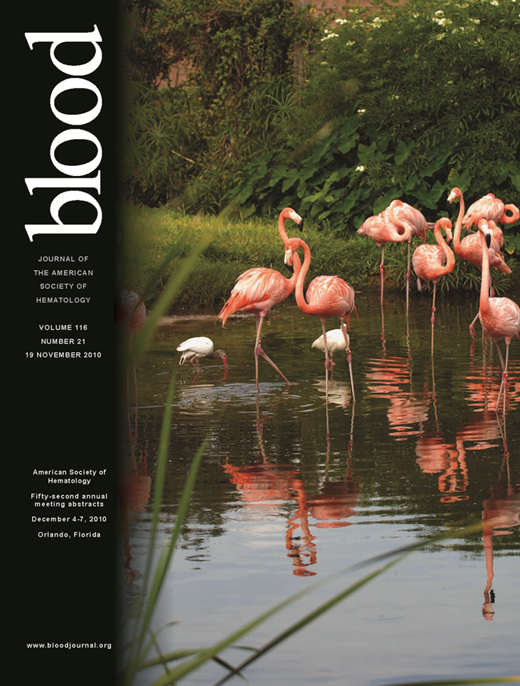Abstract
Abstract 997
Growth Factor Independence 1 (GFI1) is a transcriptional repressor, which plays an important role in myeloid differentiation. We have recently described a Single Nucleotide Polymorphism (SNP) in the GFI1 gene that is found in 15% of all AML patients and increases risk of development of acute myeloid leukemia (AML) in homozygous or heterozygous carriers of this variant. The SNP generates a GFI1 variant that carries an Asparagine residue instead of a Serine at amino acid position 36 (GFI136N). To better understand how this variant might cause leukmemia, we replaced the murine Gfi1 locus with the common form of human GFI1 (denominated GFI36S) or the variant form (GFI136N) using a previously described knockin strategy. Replacement of murine Gfi1 by human GFI136S did not affect lymphoid or myeloid differentiation demonstrating that “knocked-in” human GFI1 (Gfi1hu36S/hu36S) can fully substitute the endogenous murine gene. However, mice homozygous for the variant GFI136N allele (Gfi1hu36N/hu36N) featured a 3-fold increase in the number of both Common myeloid progenitors (CMPs) and Granulocytic monocytic progenitors (GMPs) compared with wt or Gfi1hu36S/hu36S mice (p’0.001). In addition, in the GMP fraction from Gfi1hu36N/hu36N mice more dividing cells (20 %) were found compared to the GMP fraction originating from wt or Gfi1hu36S/hu36S mice (p≤0.01). Moreover, we observed a 3-fold increased expression of the proleukemogenic transcription factors Hoxa9 and Pbx1 in GMPs from Gfi1hu36N/hu36N compared to wt or Gfi1hu36S/hu36S animals (p≤0.01). This increased level of Hoxa9 would be consistent with recent publications showing that Gfi1 is required for the repression of Hoxa9 expression in GMP/CMP subsets. Interestingly, AML patients heterozygous for the GFI136N variant showed a tendency toward a 2-fold higher expression of the Hoxa9 gene when compared with GFI136S homozygous patients.
To explain how the presence of the variant might predispose to leukemia, we performed a gene expression array of GMPs from Gfi1hu36N/hu36N, wt mice, Gfi1ko/ko or Gfi1hu36S/hu36S mice. Whereas wt and Gfi1hu36S/hu36S mice showed a similar gene expression pattern, the presence of the GFI136N variant led to a reprogramming of the GMP population with dysregulation of genes known to be involved in AML such as Idh1, Tet2 and Trib1. The gene expression pattern was also distinct from the pattern of sorted Gfi1ko/ko GMPs, pointing to a specific role of GFI136N in reprogramming the progenitor fraction and thus predisposing to AML. Interestingly, some of the genes differentially regulated between Gfi1hu36N/hu36N GMPs and the other GMPs were also differentially expressed between GFI36S patients and GFI136N heterozygous AML patients. We examined the biochemical features of the two Gfi1 variants in order to explain how the variant might reprogramm the GMPs and predispose to AML. Both GFI136N and GFI136S are still able to bind to previously published GFI1interaction partners such as PU.1 or CEBPe. We observed that GFI136N exhibited a different intranuclear localization than GFI136S. Whereas murine Gfi1 and human GFI136S localize in dots within the nucleus, GFI136N is mainly found along the nuclear border suggesting that nuclear localization is important for Gfi1 function. This was in accordance with a previously reported AML patient homozygous for GFI136N who also exhibited a similar aberrant nuclear localization.
Finally to study a potential impact of GFI136N on myeloid leukemogenesis, we used an established mouse model in which expression of a mutated form of KRAS (K12D) can be induced causing a 100% penetrance of an AML like disease. GFI136N significantly accelerated the onset of KRAS driven leukemia in these mice which was associated with a higher number of blast cells in the bone marrow, blood and spleen (p’0.05 for blast number and latency). These data suggest that the GFI136N variant predisposes to the development of AML since it is inefficient in repressing Hoxa9 owing to an aberrant subnuclear localization. To our knowledge this is the first knock-in of a human protein variant predisposing to AML and this mouse model could help developing a targeted therapy for these patients.
No relevant conflicts of interest to declare.
Author notes
Asterisk with author names denotes non-ASH members.

